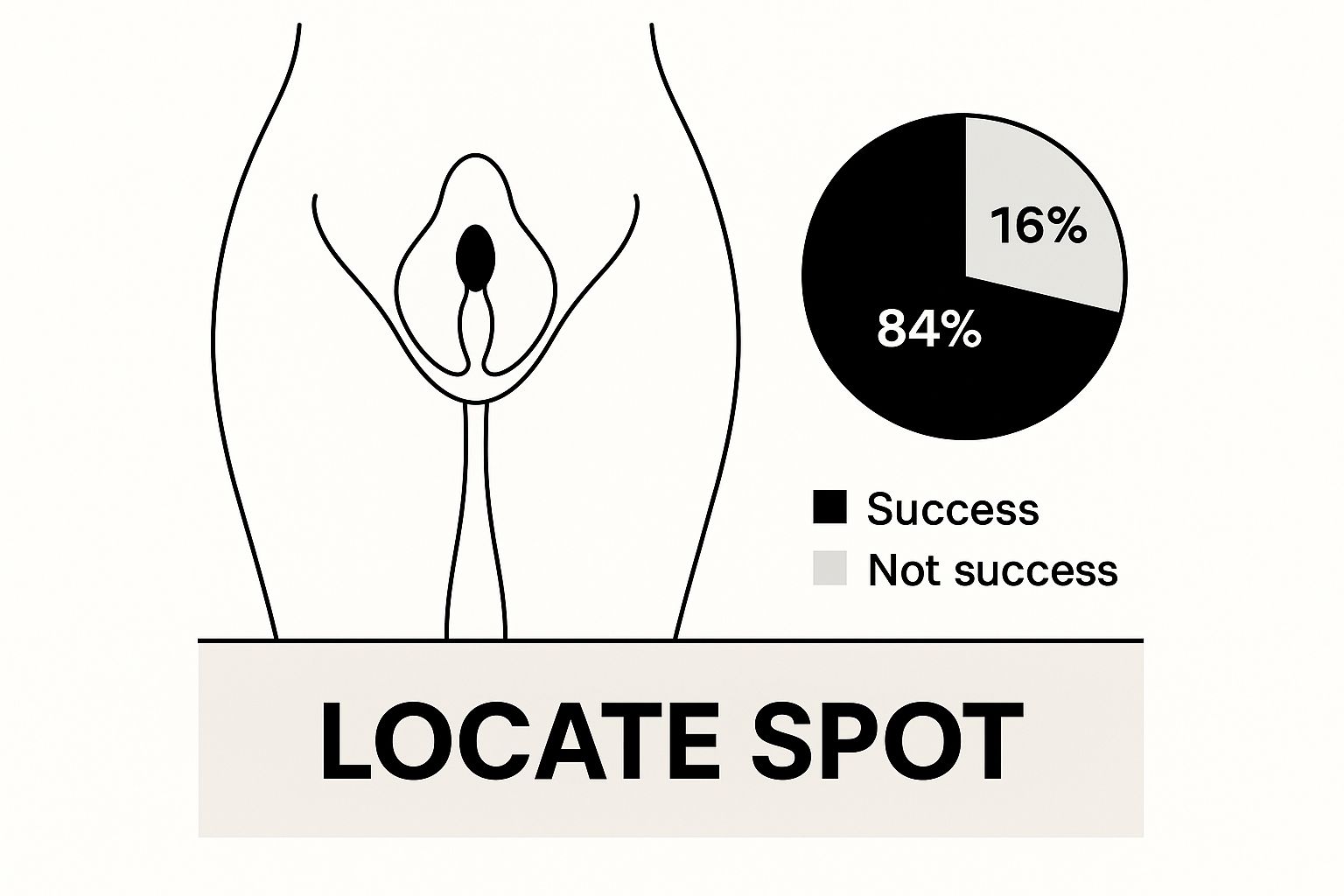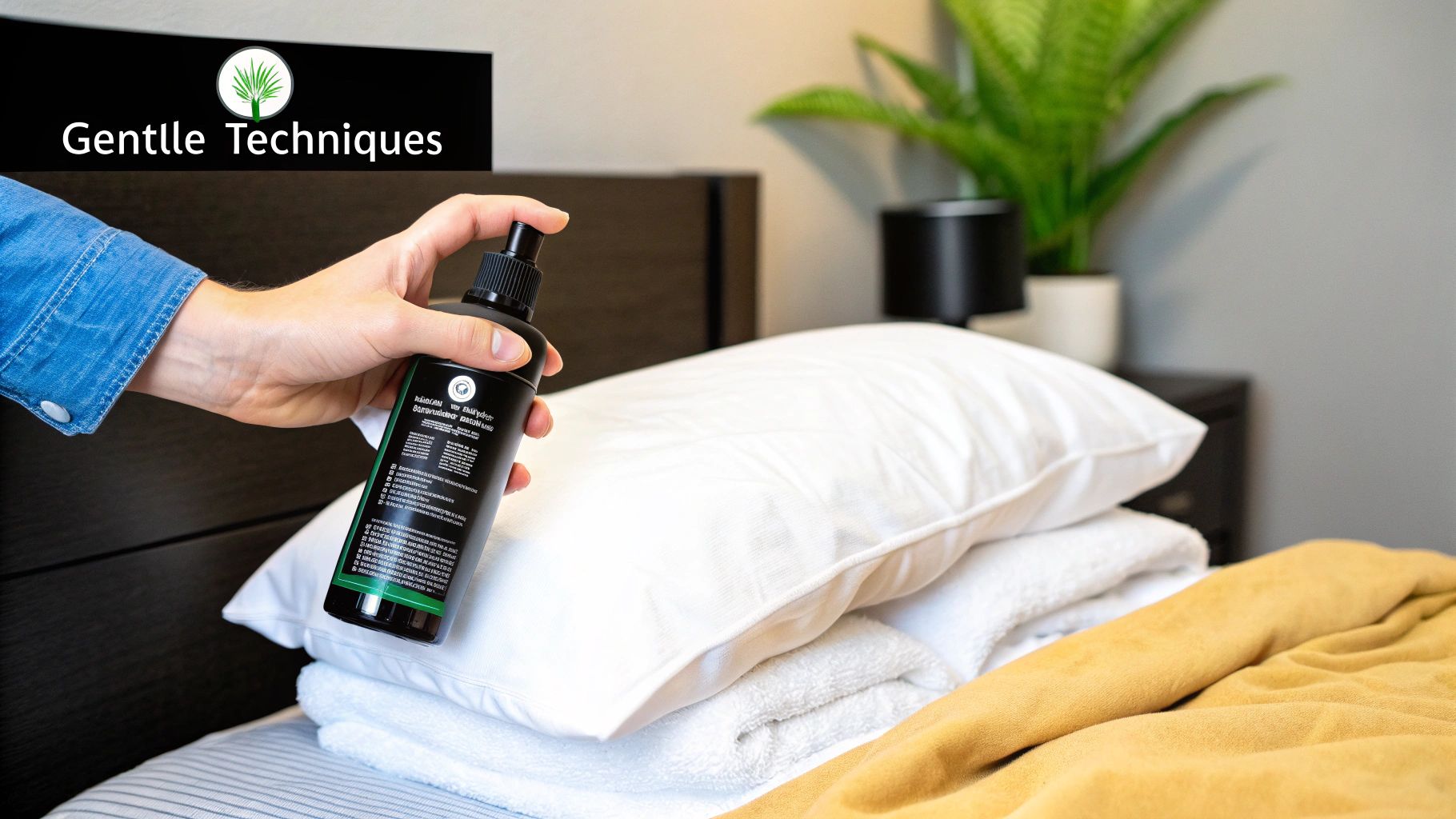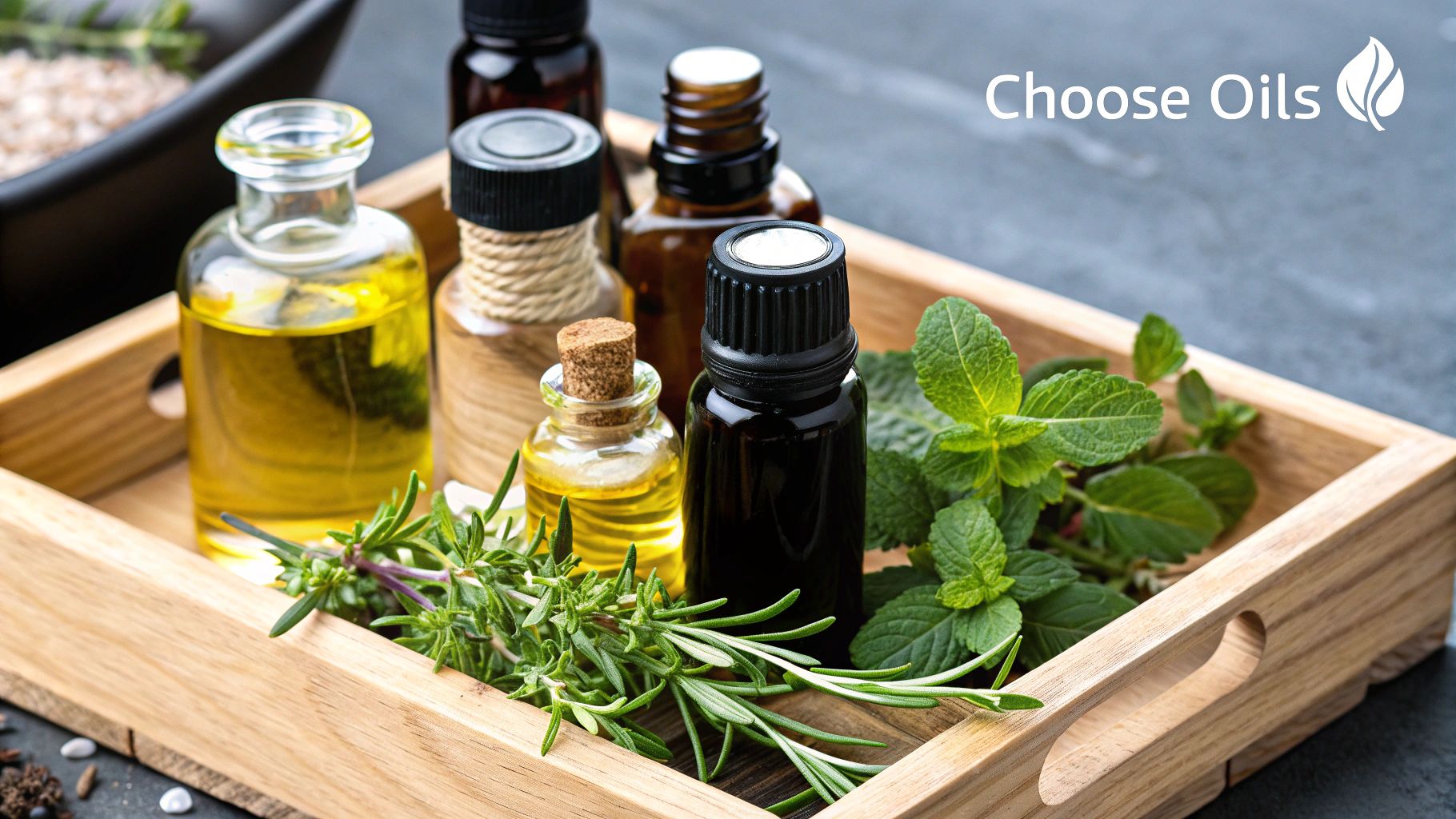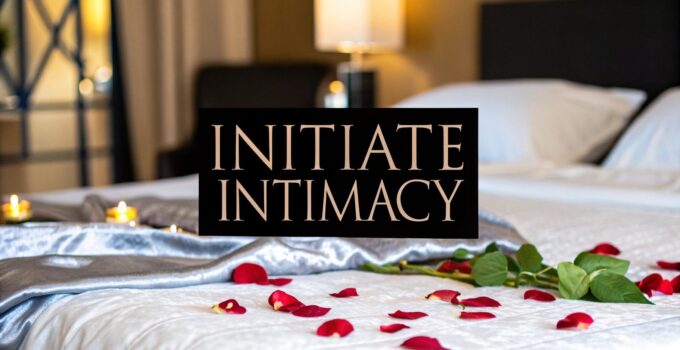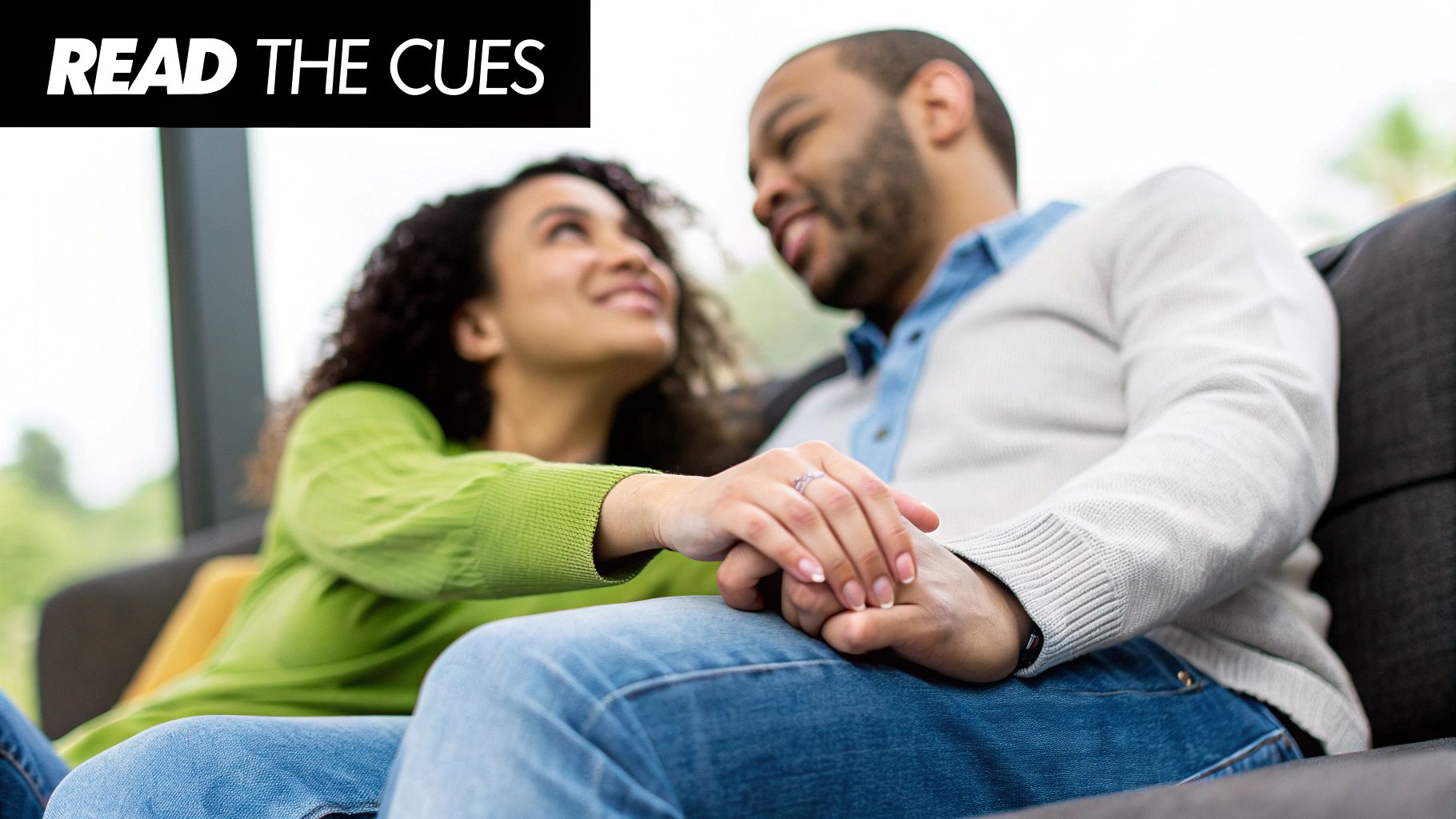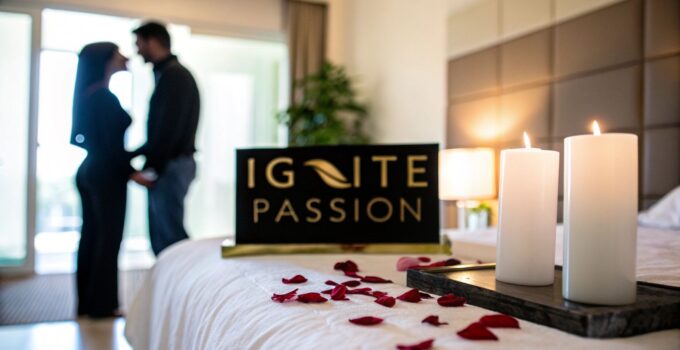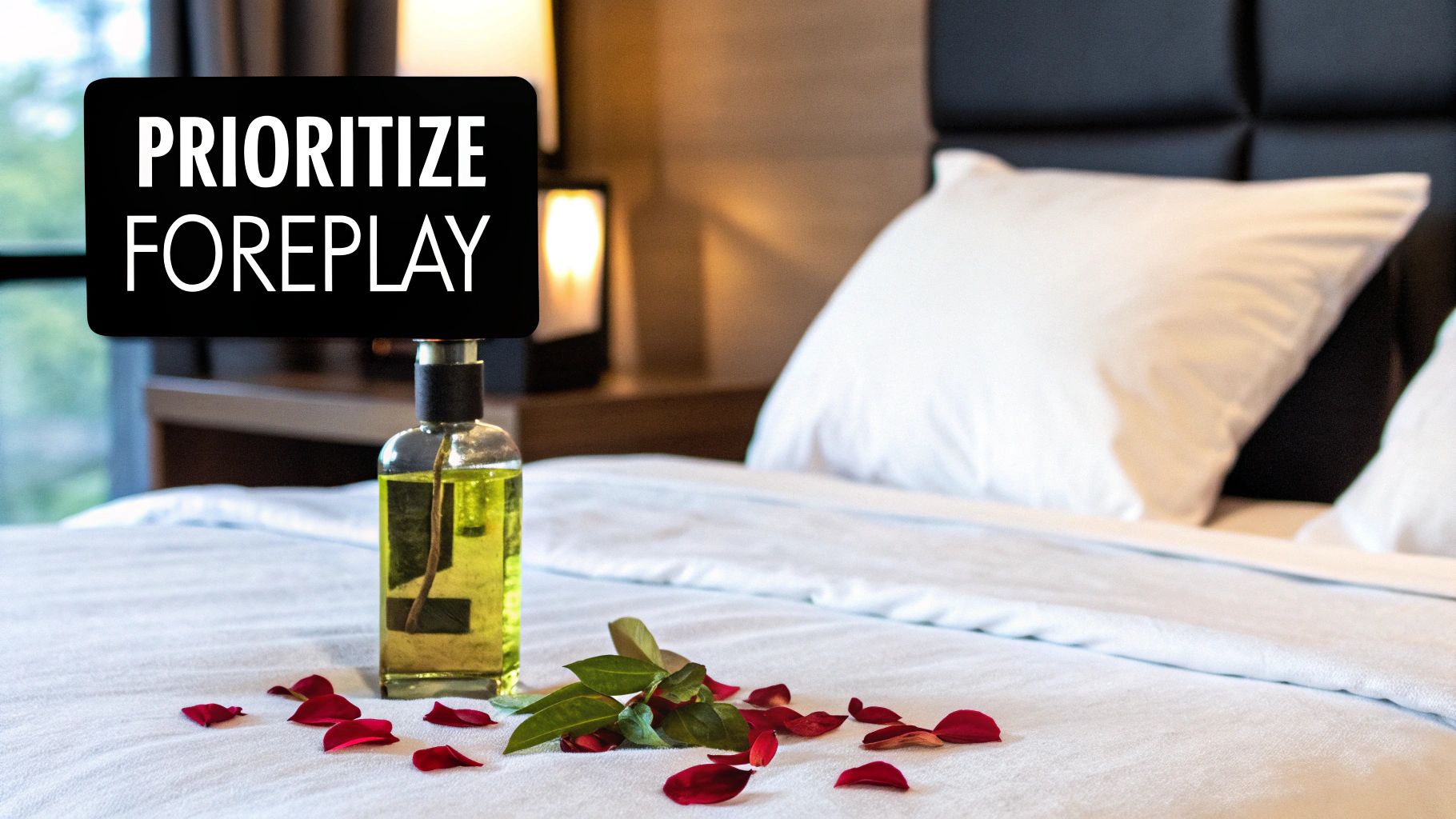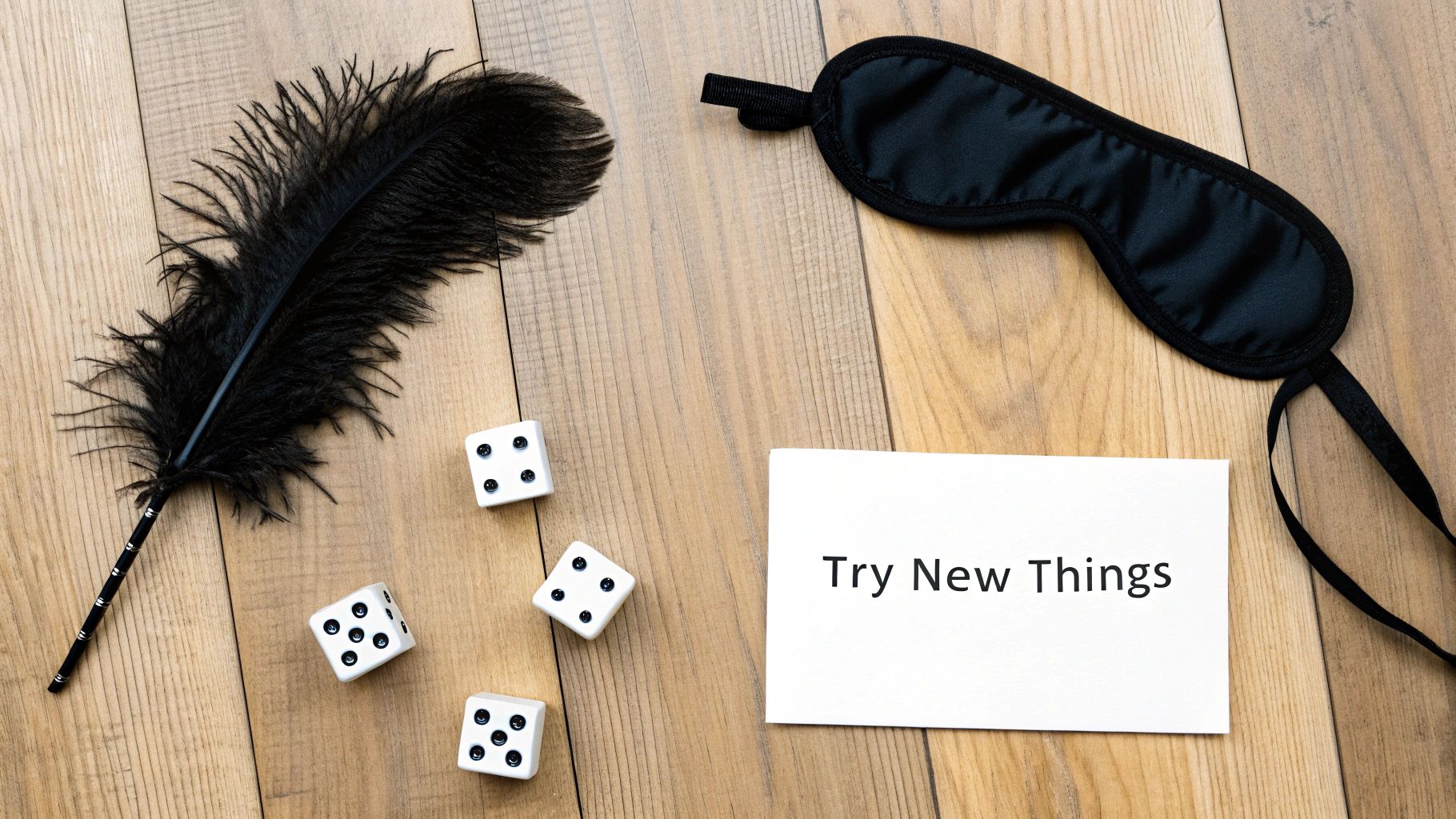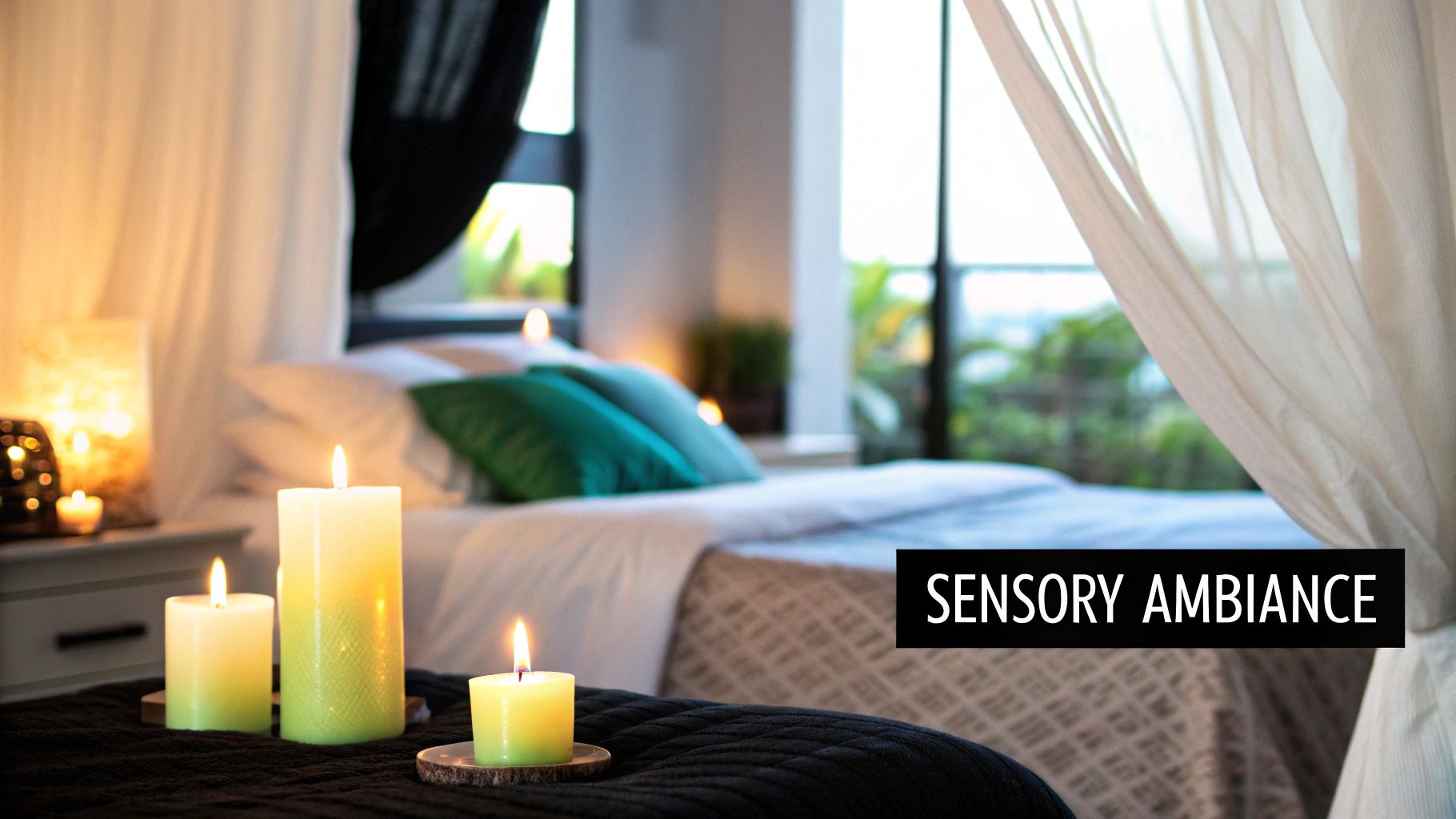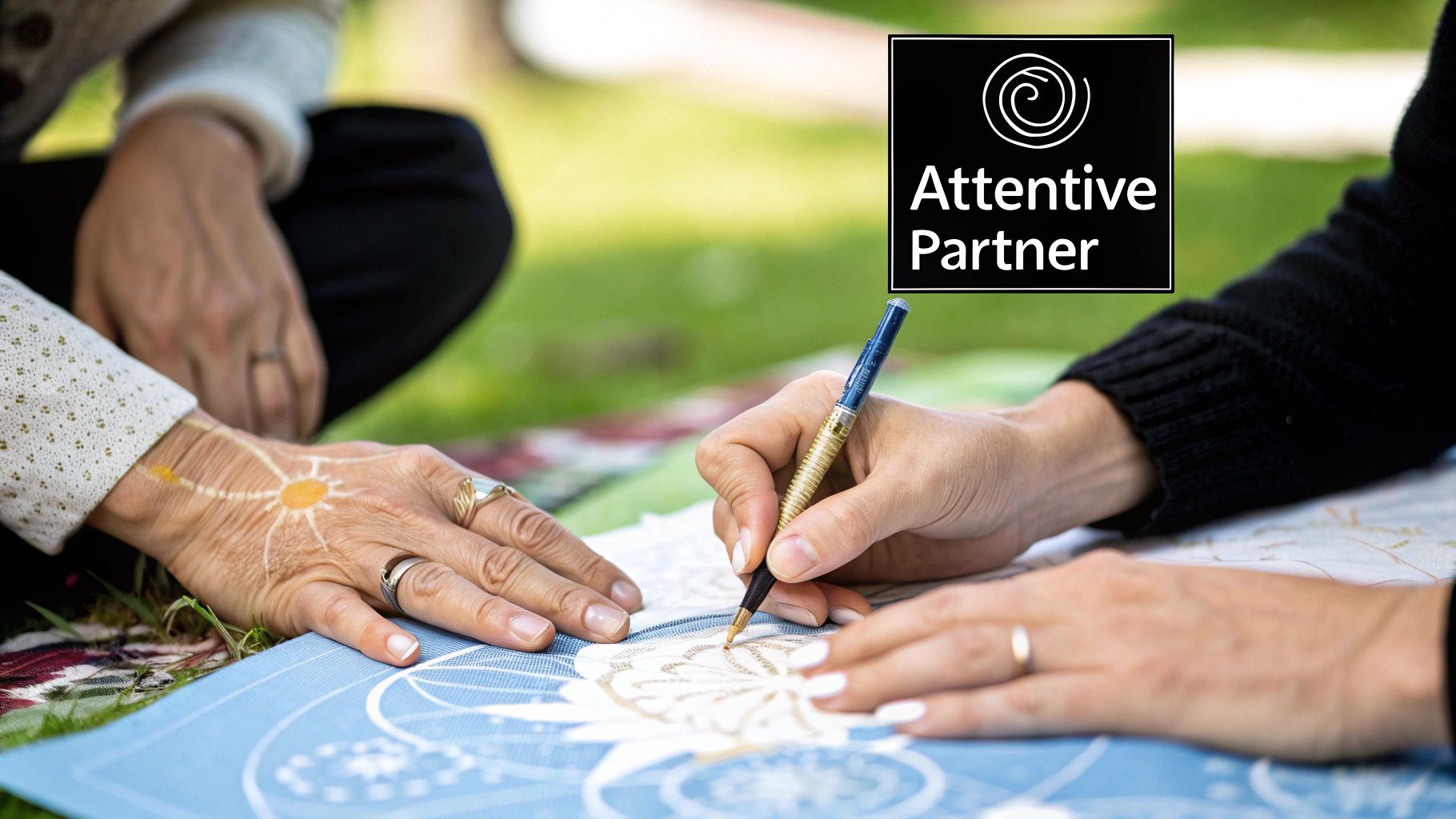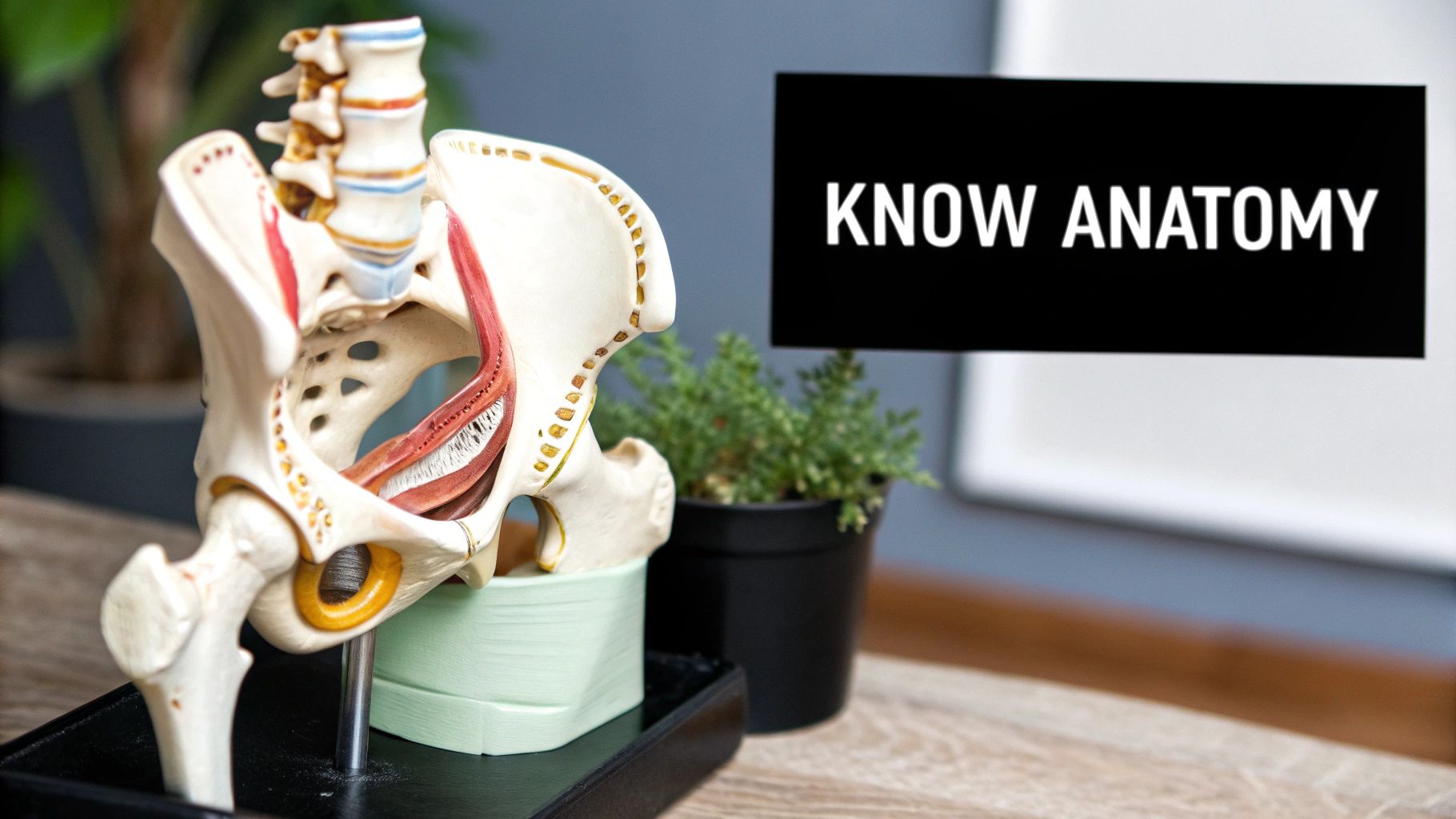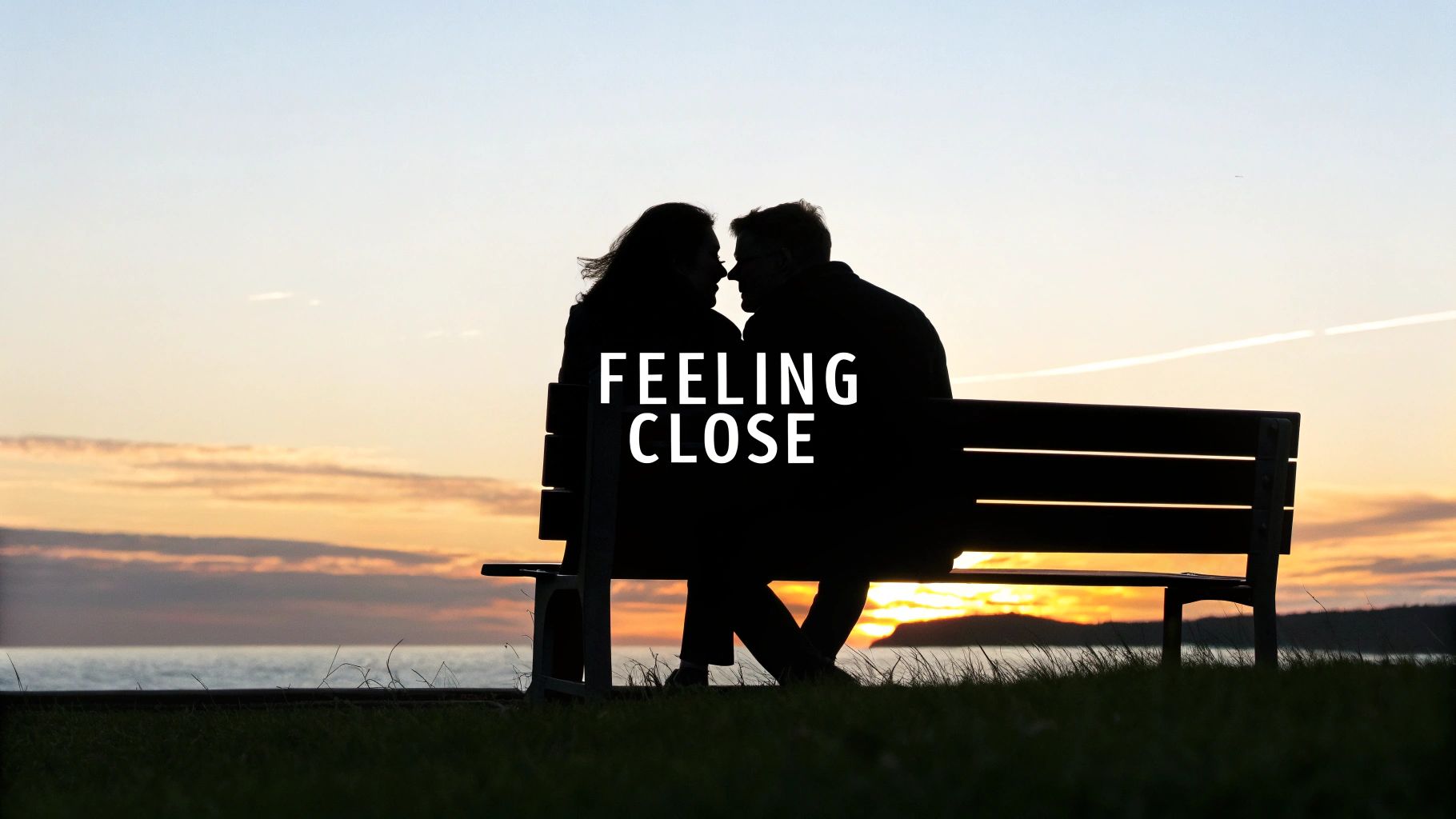6 Erogenous Zones for Women to Explore in 2025
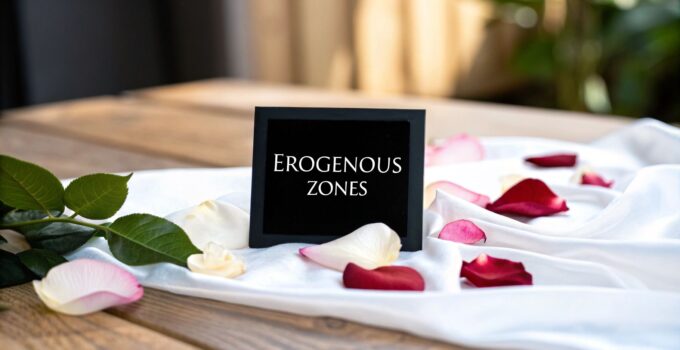
Unlocking Female Pleasure: A Guide to Erogenous Zones
Want to deepen intimacy and pleasure with your partner? Understanding female erogenous zones is key. This guide explores six key areas on a woman's body—including the clitoris, nipples, neck, inner thighs, ears, and G-spot—to ignite passion and enhance pleasure. Whether exploring solo or with a partner, learning about these erogenous zones for women will unlock deeper intimacy and satisfaction for everyone. Let's dive in.
1. Clitoris
When discussing erogenous zones for women, the clitoris reigns supreme. It's not just an important area; it's the primary source of pleasure for most women. This small but mighty organ boasts approximately 8,000 nerve endings, a concentration rivaling that of the fingertips, making it incredibly sensitive and responsive to stimulation. Understanding its anatomy and how it works is key to unlocking intense pleasure for your partner. The clitoris extends beyond the visible external nub (glans clitoris) and has internal structures, including the crura or "roots," which wrap around the vagina. This means that even indirect stimulation can be arousing. The primary purpose of the clitoris is sexual pleasure—it's the only human organ dedicated solely to this function, solidifying its place at the top of this list of erogenous zones for women.

Features and Benefits:
- Exceptional Nerve Density: The approximately 8,000 nerve endings concentrated in a small area contribute to the clitoris's extreme sensitivity.
- Internal and External Structures: Stimulation of the external glans as well as the internal structures (crura/roots) can contribute to arousal and orgasm.
- Highly Responsive: The clitoris is remarkably responsive to various types of touch, pressure, and vibration.
- Intense Orgasms: Direct or indirect clitoral stimulation is the most common way women achieve orgasm.
Pros:
- Potential for Intense Pleasure: The clitoris’s sensitivity makes it capable of producing powerful orgasms.
- Versatility in Stimulation: It responds well to a variety of techniques, from gentle touch to firm pressure and vibration.
- Accessibility: The external glans clitoris can be stimulated without penetration, allowing for diverse forms of intimacy.
Cons:
- Sensitivity and Potential Discomfort: For some women, direct stimulation can be too intense, especially initially. Starting slow and gentle is crucial.
- Individual Variation: Clitoral size and sensitivity vary, meaning what works for one woman might not work for another. Communication is essential.
- Anatomical Understanding: Partners unfamiliar with female anatomy may struggle to locate or stimulate the clitoris effectively. Taking the time to learn is important.
Tips for Successful Stimulation:
- Start Slow and Gentle: Begin with light, indirect stimulation around the clitoris before gradually increasing pressure and intensity based on your partner's response.
- Lubrication is Key: Use a good quality lubricant to reduce friction and enhance pleasurable sensations.
- Variety is the Spice of Life: Experiment with different pressures, rhythms, and motions. Circular motions, tapping, and varying the pressure can be very stimulating.
- Combine with Other Touches: Incorporate clitoral stimulation with other forms of touch, such as kissing, caressing, and massage, for a more holistic and pleasurable experience.
- Communicate Openly: Talk to your partner! Ask them what they like and dislike, and pay attention to their nonverbal cues. Open communication is crucial to maximizing pleasure and ensuring a positive experience.
Understanding the clitoris and its role in female pleasure is vital for any man seeking to please his partner. By learning about its features, understanding its sensitivity, and employing effective stimulation techniques, you can greatly enhance your partner's sexual experience and deepen your intimacy.
2. Nipples and Breasts
When exploring erogenous zones for women, the nipples and breasts are a prominent area of focus, deserving a high spot on the list. These areas are richly supplied with specialized nerve endings that connect directly to the genital sensory cortex in the brain. This neural connection explains why stimulation of the nipples and breasts can produce intense pleasure for many women. In fact, for some, this stimulation activates the same brain regions as genital stimulation, and can even lead to orgasm, sometimes referred to as a nipple-gasm or breast orgasm. This makes understanding how to effectively stimulate this zone crucial for enhancing intimacy and pleasure.

The responsiveness of the nipples and breasts stems from their complex network of nerve endings, making them receptive to a variety of sensations. They respond not only to touch, but also to changes in temperature and pressure. This sensitivity, however, is not static. It can fluctuate throughout the menstrual cycle due to hormonal shifts, and varies significantly from woman to woman. What one woman finds intensely pleasurable, another may find uncomfortable, highlighting the importance of communication and experimentation.
One of the key advantages of this erogenous zone is its accessibility. Incorporating nipple and breast play into foreplay or lovemaking is relatively straightforward. It can greatly enhance overall sexual pleasure when combined with stimulation of other erogenous zones. For instance, gentle caressing of the breasts while kissing can heighten arousal and create a more intimate connection. Some women find that focusing on the breasts first allows them to relax and become more receptive to other forms of stimulation.
Pros:
- Easily accessible erogenous zone.
- Can enhance overall sexual pleasure when combined with other stimulation.
- For some women, can trigger orgasms independently.
Cons:
- Sensitivity can vary greatly among individuals.
- May become uncomfortable or painful if stimulation is too intense.
- Sensitivity can change during pregnancy, breastfeeding, or hormonal fluctuations.
Tips for Successful Stimulation:
- Start Gently: Begin with light touches and caresses around the breast area before focusing directly on the nipple. This allows your partner to acclimate to the sensation and helps you gauge her sensitivity.
- Vary the Sensations: Experiment with different types of touch, such as stroking, circling, light pinching, or even temperature play (using ice or warm water). See what elicits the most positive response.
- Pressure Control: Use varying levels of pressure to determine what your partner finds most pleasurable. Remember, what feels good one day might feel different the next. Communication is key.
- Incorporate Massage: Including breast massage as part of foreplay can be incredibly sensual and relaxing. Use gentle, circular motions, working outward from the nipple.
- Be Mindful of Changes: Be aware that preferences and sensitivities can change throughout the menstrual cycle, during pregnancy, or with hormonal fluctuations. Always check in with your partner to ensure her comfort and pleasure.
By understanding the nuances of this erogenous zone—its sensitivity, its connection to the brain, and the individual variations in response—men can greatly enhance their partner's pleasure and create a more fulfilling and intimate sexual experience. Remember, open communication, attentiveness, and a willingness to experiment are essential for maximizing the pleasure potential of this powerful erogenous zone for women.
3. Neck and Nape
The neck, and especially the nape (the back of the neck), is a frequently overlooked yet highly sensitive erogenous zone for women. This area is rich in nerve endings, and its sensitivity stems from its direct connection to the central nervous system and its proximity to major blood vessels. The combination of thin skin and this dense network of nerve endings makes the neck and nape particularly responsive to light touches, kisses, and even warm breath. This responsiveness makes it a powerful area to explore when seeking to increase intimacy and arousal.

The neck's connection to the parasympathetic nervous system, responsible for the body's relaxation response, plays a key role in its erotic significance. Stimulation of this area can trigger a cascade of relaxation throughout the body, making a woman more receptive to further intimacy. Because this zone is so sensitive to even subtle changes in temperature, incorporating warm breath or cool lips can significantly heighten the sensation. Furthermore, the neck and nape are surprisingly accessible erogenous zones, offering opportunities for intimate connection in both public and private settings.
One of the significant benefits of focusing on the neck and nape is its potential to serve as a smooth transition from non-sexual to sexual touch. A gentle caress of the neck during a conversation can be an understated yet powerful way to signal romantic interest and build sexual tension. This subtle initiation can often be more effective than a more abrupt or overtly sexual advance. For men looking to understand their woman's body and deepen intimacy, understanding the power of this erogenous zone is crucial.
Pros:
- Subtle and Accessible: Can be stimulated in public settings without being overtly sexual.
- Effective Transition: Often serves as a seamless transition from non-sexual to sexual touch.
- Full-Body Response: Stimulation can trigger relaxation and arousal throughout the entire body.
Cons:
- Ticklishness: May be ticklish for some women, requiring sensitivity and adjusted technique.
- Vulnerability: Can feel vulnerable due to the exposure of vital structures in this area.
- Visibility of Marks: Marks from kissing or suction (love bites) may be visible.
Tips for Successful Implementation:
- Light Touch: Start with light, feathery touches or soft kisses rather than firm pressure. Gauge her reaction and adjust accordingly.
- Temperature Play: Incorporate warm breath against the skin for a stimulating temperature contrast.
- Gentle Nibbling: Try gentle nibbling or kissing along the hairline at the nape of the neck.
- Combine with Other Sensations: Combine neck and nape stimulation with a scalp massage or gentle hair pulling for enhanced sensation.
- Trace the Lines: Trace kisses or touches from behind the ear down to the collarbone for maximum effect.
By understanding the sensitivity and nuances of the neck and nape as an erogenous zone, men can significantly enhance their intimate connections with women. This often-overlooked area offers a powerful pathway to increased arousal, relaxation, and deeper intimacy. Experimenting with different techniques and paying close attention to your partner's responses will help you discover what works best for her and unlock the full potential of this sensual zone.
4. Inner Thighs
The inner thighs are an often-overlooked erogenous zone for women. Due to their proximity to the genitals and the abundance of nerve endings, this area is highly sensitive and serves as a powerful trigger for arousal. The skin here is generally softer and more delicate than on other parts of the legs, making it particularly receptive to touch. Stimulating the inner thighs is an effective way to build anticipation and transition towards more direct stimulation of the genitals, playing a key role in enhancing pleasure during foreplay and intercourse. Understanding how to explore this sensitive zone can significantly deepen intimacy and create a more fulfilling sexual experience for both partners.

This area deserves its place on the list of erogenous zones for women because of its unique features and benefits. The thin, sensitive skin combined with the high concentration of nerve endings creates a potent combination for arousal. Its large surface area also allows for varied stimulation, from gentle caresses to more intense touch. Furthermore, the rich network of nerve pathways connecting the inner thighs to the pelvic region contributes to the amplified sensation experienced when this zone is stimulated.
Features:
- Thin, sensitive skin with numerous nerve endings
- Close proximity to genitals, heightening anticipation
- Large surface area accommodating various stimulation techniques
- Rich in nerve pathways connecting to the pelvic region
Pros:
- Excellent for gradually building arousal
- Responds well to a wide range of touch, from light feathering to firmer pressure
- Can be stimulated during both foreplay and intercourse
Cons:
- Can be ticklish for some women
- Sensitivity levels vary between individuals
- May require more time and dedicated attention compared to more direct erogenous zones
Examples of Successful Implementation:
- During foreplay: Transition smoothly from massaging the legs to focusing on the inner thighs, gradually increasing the intensity of the touch.
- Leading to oral sex: Light kisses or licks along the inner thigh create a tantalizing pathway towards the genitals.
- During intercourse: Gentle caressing of the inner thighs in positions like missionary or woman-on-top maintains and enhances arousal.
Tips for Stimulating the Inner Thighs:
- Gradual Approach: Begin with light touches on the outer thigh and progressively move inwards, allowing your partner to acclimate to the sensation.
- Varying Pressure: Alternate between feather-light strokes and firmer pressure to discover what your partner finds most pleasurable.
- Temperature Play: Experiment with different temperatures, such as warm breath, cool air, or the warmth of your hands.
- Incorporate Massage: Gentle massage can be incredibly arousing. Gradually move your hands from the knees towards the groin.
- Light Teasing: Try light scratching or trailing your fingertips from the knee to the groin to build anticipation.
By understanding the sensitivity and responsiveness of the inner thighs, men can effectively use this erogenous zone to enhance pleasure for their partners and deepen intimacy during sexual encounters. This area is a valuable tool for building arousal, transitioning between different forms of stimulation, and creating a more fulfilling experience for both individuals.
5. Ears
The ears, often overlooked, are surprisingly sensitive erogenous zones for women and deserve a prominent place on this list. Their intricate network of nerve endings and close proximity to the brain's pleasure centers make them a powerful trigger for arousal. Understanding how to effectively stimulate a woman's ears can significantly enhance intimacy and pleasure.
The sensitivity stems from the rich nerve supply in and around the ear, including connections to the vagus nerve, which plays a crucial role in the parasympathetic nervous system – the system responsible for relaxation and arousal. The thin skin of the ear, particularly on the lobe, helix (outer rim), and tragus (small cartilage flap covering the ear canal), is highly receptive to touch, temperature changes, and even sound. This sensitivity contributes to the ears' effectiveness as erogenous zones for women.
How Ear Stimulation Works:
Stimulating the ears activates these nerve endings, sending signals directly to the brain's pleasure centers. For many women, this can create a cascade of pleasurable sensations throughout the body. This neurological connection to other erogenous zones can amplify arousal and contribute to a more intense experience. The combination of physical touch, the warmth of breath, and suggestive sounds can be particularly potent.
Examples of Successful Implementation:
- Gentle Nibbling and Kissing: Lightly nibbling or kissing the earlobe is a classic and often effective way to introduce ear play.
- Whispering Sweet Nothings: Combining soft whispers with warm breath against the ear can heighten the sensual experience. Try whispering compliments, expressing desire, or simply breathing gently.
- Tracing the Ear's Contours: Lightly tracing the outer edge of the ear, including the helix and tragus, with your tongue or fingertip can be incredibly stimulating. Varying the pressure from feather-light to slightly firmer can further enhance the sensation.
- Combining Sounds and Touch: The ears are, of course, the primary organ for hearing. Combining physical touch with auditory stimulation, like soft moans, whispers, or even music, can create a powerful synergistic effect.
Tips for Stimulating a Woman's Ears:
- Start Slowly and Gently: Gauge her reaction and adjust your approach accordingly. Some women are more sensitive than others.
- Pay Attention to Her Responses: Nonverbal cues like sighs, moans, or changes in breathing can indicate what she finds pleasurable.
- Communicate: Ask her what she likes and dislikes. Open communication is key to a fulfilling experience for both partners.
- Vary Your Techniques: Experiment with different types of touch, pressure, and sounds.
- Consider the Environment: A quiet, intimate setting can enhance the experience, but discreet stimulation in public can also be exciting.
Pros of Ear Stimulation:
- Easy Accessibility: The ears are readily accessible in most situations.
- Socially Acceptable Touch: Touching someone's ear is often considered more socially acceptable than touching other erogenous zones, making it easier to incorporate into public displays of affection.
- Full-Body Response: Minimal contact can trigger powerful full-body sensations.
Cons of Ear Stimulation:
- Ticklishness: Some women may be ticklish or uncomfortable with ear stimulation.
- Varying Sensitivity: Ear sensitivity varies significantly between individuals.
- Moisture Sensitivity: Some women may find moisture in the ear canal uncomfortable.
By understanding the sensitivity of the ears and employing these techniques, you can unlock a new dimension of pleasure and intimacy with your partner. Remember to be gentle, communicative, and attentive to her responses to make the experience truly enjoyable.
6. G-Spot: Unlocking Deeper Pleasure
The G-spot (Gräfenberg spot) is a frequently discussed erogenous zone for women, and for good reason. Understanding its location, function, and how to stimulate it can significantly enhance your partner's pleasure and deepen your intimacy. This area deserves its place on the list of erogenous zones due to its potential to trigger intense orgasms and a unique form of pleasure different from clitoral stimulation. Knowing how to explore this zone can open up a whole new world of sensation for your partner.
What is the G-Spot and How Does it Work?
Located approximately 1-3 inches inside the vagina along the front wall, the G-spot isn't a distinct organ but rather part of the larger internal clitoral structure and urethral sponge. This spongy, slightly ridged tissue swells with blood flow during arousal, becoming more pronounced and sensitive. When stimulated correctly, it can produce intense, deep orgasms, often accompanied by a sensation distinct from clitoral stimulation. For some women, G-spot stimulation can also lead to female ejaculation, a release of fluid often described as clear and odorless.
Features and Benefits:
- Location: 1-3 inches inside the vagina on the anterior wall.
- Structure: Part of the internal clitoral complex and urethral sponge.
- Texture: Feels slightly ridged or textured compared to surrounding tissue.
- Arousal Response: May swell or become more prominent during arousal.
- Benefits: Can produce intense, deep orgasms; May lead to female ejaculation for some women; Often responds well to firm pressure.
Pros and Cons of G-Spot Stimulation:
Pros:
- Intense Orgasms: G-spot orgasms are often described as deeper and more full-bodied than clitoral orgasms.
- Female Ejaculation: Stimulating the G-spot can trigger female ejaculation in some women, adding another layer of excitement and pleasure.
- Pressure Sensitivity: Unlike the clitoris, the G-spot often responds better to firm, consistent pressure rather than light touches.
Cons:
- Difficult to Locate: Finding the G-spot can be challenging, especially if your partner isn't already aroused.
- Varying Sensitivity: Sensitivity varies greatly among individuals. Some women find it highly pleasurable, while others experience little to no sensation.
- Potential Discomfort: Some women report discomfort rather than pleasure when the G-spot is stimulated. Communication is key to ensuring a positive experience.
Tips for Successful G-Spot Stimulation:
- Ensure Sufficient Arousal: The G-spot is much easier to locate and stimulate when a woman is already aroused. Engage in foreplay beforehand to increase blood flow to the area.
- Use a "Come Hither" Motion: Insert two fingers into the vagina and curve them upwards towards the belly button.
- Apply Firm, Consistent Pressure: Experiment with different levels of pressure, but generally, firm pressure is more effective than light touches.
- Experiment with Different Positions: Woman-on-top or doggy style positions can provide better access to the G-spot.
- Combine with Clitoral Stimulation: Combining G-spot stimulation with clitoral stimulation can create an incredibly powerful and pleasurable experience.
- Communicate: Talk to your partner! Ask her what feels good and adjust your technique accordingly.
Video Demonstration:
By understanding the nuances of G-spot stimulation and practicing these tips, you can unlock a deeper level of pleasure for your partner and enhance your intimacy. Remember, communication and experimentation are crucial to discovering what works best for both of you. Exploring this erogenous zone can be a rewarding experience for both partners when approached with sensitivity and patience.
Top 6 Female Erogenous Zones Comparison
| Erogenous Zone | Implementation Complexity 🔄 | Resource Requirements ⚡ | Expected Outcomes 📊 | Ideal Use Cases 💡 | Key Advantages ⭐ |
|---|---|---|---|---|---|
| Clitoris | Moderate: Requires understanding of anatomy and individual preferences | Low: Mainly manual stimulation, lubricant recommended | High: Intense orgasms, strong sexual pleasure | Direct or combined stimulation during foreplay or sex | Highly sensitive, multiple stimulation types |
| Nipples and Breasts | Low: Simple touch techniques, varied pressure | Low: Hands, mouth, temperature play options | Moderate to high: Can induce orgasms, enhance pleasure | Foreplay, combined stimulation with other zones | Easily accessible, potential for nipple-gasms |
| Neck and Nape | Low to moderate: Light touch techniques preferred | Very low: Hands, breath, minimal tools | Moderate: Full-body response, relaxation | Public-friendly stimulation, transition from non-sexual to sexual | Discreet, triggers relaxation and arousal |
| Inner Thighs | Moderate: Gradual approach needed to avoid ticklishness | Low: Hands, temperature changes, massage tools optional | Moderate: Builds arousal, excellent teasing zone | Foreplay, teasing before genital stimulation | Large area, good for anticipation building |
| Ears | Low: Gentle nibbling, whispering, varied pressure | Very low: Hands, mouth, voice | Moderate: Full-body response via neurological pathways | Discreet touch, enhancing intimacy in public or private | Socially acceptable, neurological arousal link |
| G-Spot | High: Requires anatomical knowledge, technique, and arousal | Moderate: Manual stimulation, possible use of toys | High: Deep, intense orgasms, possible female ejaculation | Deep stimulation during sex, combined with clitoral touch | Unique internal pleasure zone, potential for varied orgasm types |
Exploring Intimacy and Pleasure
Understanding the erogenous zones for women, from the clitoris and G-spot to often-overlooked areas like the neck, ears, and inner thighs, is key to unlocking deeper levels of pleasure and connection with your partner. We've explored six key areas in this article, but remember, this is just a starting point. Every woman experiences pleasure differently, and what works for one may not work for another. The most important takeaway is the importance of communication and exploration.
Deepening intimacy often involves understanding and responding to your partner's needs and desires. Consider using empathy as you explore these erogenous zones together. By tuning into her verbal and nonverbal cues, you can discover what truly brings her pleasure and create a more fulfilling experience for both of you. Mastering these concepts empowers you to build stronger intimacy, enhance your sexual connection, and cultivate a more satisfying and pleasurable relationship.
Want to dive even deeper into understanding the female anatomy and maximizing pleasure? Check out G-Spot 101 for comprehensive sex education and guidance specifically designed to enhance your understanding of erogenous zones for women and unlock new levels of intimacy. It's a valuable resource for anyone looking to create a more fulfilling and connected intimate life.



